Renesas' best-in-class automotive sensor signal conditioning (SSC) ICs are optimized to withstand harsh automotive environments that require low supply current to reduce power consumption (critical for PHEV, BEV, and FCEV vehicles), and provide excellent electromagnetic compatibility and ESD protection. In addition, these SSCs products offer digital compensation of inherent sensor offset, sensitivity, temperature drift, and nonlinearity covering a wide operational temperature range according to the AEC-Q100 standard (–40 °C to +150 °C).
To support ASIL requirements according to ISO 26262, multiple diagnostic and monitoring functions have been implemented on the SSCs to support OEMs and automotive sensor module suppliers. This ensures the SSCs support safety-critical sensor applications linked to transmission and braking, as well as other applications such as DPF, EGR, and HVAC.
Renesas’ SSCs are compatible with multiple pressure sensor types, such as piezoresistive MEMS, ceramic, and strain gauge for correct measurement of absolute, gauge/barometric and differential pressure. Renesas’ SSCs support high-temperature sensing using thermocouples.
These SSCs support various external temperature sensors, namely diode, RTD, TCR, and internal PTAT for correct temperature measurements. The output interfaces supported by SSCs include Analog, SENT, LIN, PWM, and I2C.
The end-of-line calibration of SSCs, supported via the output pin, uses one-wire interface (OWI) to reduce test time, ensuring calibration equipment communicates digitally. Digital calibration helps keep the customer’s overall assembly costs low, as trimming of sensing elements by external devices or lasers is not needed. The new generation of SSCs enables customers to easily create a wide variety of sensor platforms by offering drop-in-compatibility and identical Pin & Pad layout when using the ZSSC41xx family.
The SSC evaluation kits are designed to provide an overview of the functions and configuration options for Renesas’ SSC IC family. These kits provide support for new and experienced users in the evaluation and design of their sensor modules.


